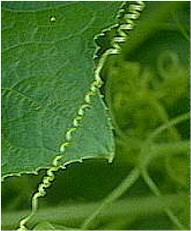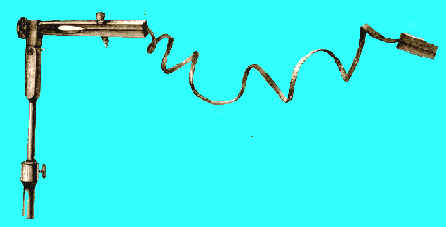The shoots above ground of most species are usually stable enough to keep upright by themselves. Some species, though, have shoots that would break upon the weight of their own organs. They can only grow upright when winding themselves around a vertical or almost vertical support (climbers). Besides exist species with specially developed organs, so-called tendrils, that wind themselves both around horizontal or vertical supports. Some species have moreover specialized holdfasts with which they attach themselves by suction to bases of different orientations. Finally is a further group known that develops clinging to bases of the most diverse kind (an example is Rubus fructicosus, the blackberry).
In contrast to the common use of the term that does often describe long shoots – like that of ivy – as tendrils, does the botanical term mean thin, long, and thread-shaped organs that have a very high degree of irritability for touch and friction on solid bodies when fully differentiated. This property allows them to wind tightly around a thin rod, a shoot, the stalk of another plant, the twigs of a wooden shrub or similar things.
Among the characteristic tendril plants are the Curcubitaceae (like Bryonia dioica), the Passifloraceae, Vitis vinifera and its relatives, many Leguminosae (Pisum sativum; many species of Vicia), etc.

The tendrils of the different species or plant groups stem from different organs and are not homologous. They can be changed shoots (as in the case of Vitis), specialized leaves (Pisum), leaflets (Vicia, Lathyrus), leaf stalks (Clematis) or parts of roots that originate directly from the shoot (Vanilla). In the case of Vitis vinifera and Bryonia dioica, for example, are the tendrils lateral shoots usually opposite to a leaf.
Tendrils are mostly of a dorsiventral structure, and C. DARWIN has already pointed out that tendrils with tips able to bend into all directions exist, while others can only be excited at the ventral side (the morphological lower side) and do also bend only in this direction. Finally exist tendrils that do bend only towards the ventral side but can be excited on all sides.
In order to understand the movements of tendrils has it to be distinguished between two subsequent phases. The first and obligatory phase is an autonomous movement, the second belongs to the induced movements, and starts, if at all, only when the tip of the tendril has found a support.
Tendrils are usually rolled in during their early developmental stages and take on the characteristic movements only after they have unrolled. The tip starts with an autonomous circling movement described as circumnutation by C. DARWIN. The movement is caused by an increased growth of the morphological upper side (the dorsal side) that would, by itself, only lead to a rolling in (a spiral). This is prevented by a migration of the growth zone that winds in a screw-like direction around the longitudinal axis. Circumnutation may take several days during which the length of the tendril increases continuously. After reaching its full length in a fruitless search is the movement stopped, the irritability decreases, and – depending on the species – does the tendril either whither, die, and fall off the plant, or the roll up again.
If the search for a support is successful, then starts a directed bending movement. Bending occurs only, if the neighbouring parts are stimulated in a subsequent order, and if the irritation prevails for some time. A suitable support results in the development of a loop. In the case of thin supports can this loop become increasingly narrower. The free end of the tendril continues to bend and winds itself in new loops around the support until even the last bit of it is tightly wound up. The closer the part where the tendril touched the support at first is to the tendril’s base, the more loops result. The part between this point and the tendril’s base cannot wind around the support although the bending stimulus exerts also to this part of the tendril. As a consequence rolls this part often in forming numerous loops. The screw threads form turning points with the same amount of loops between them.


C. DARWIN understood that their existence is no specific property of tendrils or of the stimulus, but a mechanical necessity. If a body that is fixed at both ends starts to turn around its own axis, result torsion forces that can only be compensated for by a change of the turning’s direction (or by rupturing; see also the behaviour of the DNA during replication).
W. PFEFFER detected openings in the wall of the irritable cells of the cucumber’s tendril that he called touching pits. G. HABERLANDT could show that they exist in the tendrils of numerous other species, too. These openings allow a local contact of plasmalemma and its surrounding. It is therefore suggesting itself that a direct connection between these phenomena and the recognition of stimuli exists. How the stimulus is perceived, how it is conducted and how it is finally converted into a growth reaction remains nevertheless a still unsolved problem. It is experimentally proven that the turgor of the ventral cells decreases, that of the dorsal ones rises, and that the elongation of the wall is thereby started. In order to understand these phenomenons, can it be assumed that the permeability of the membranes (= the activity of the required permeases) in the cells is changed thus inducing a flow of ions. It looks as if these processes were ATP-consuming, which is not too astounding since we are dealing with active transport. Finally remains to be said that the tendrils change both morphologically and physiologically after having contacted the support. The tissue hardens and the contact is stabilized. All this hints at the fact that the stimulus is a signal that induces new metabolic activities, and that the stimulation activates genes that had been inactive before.